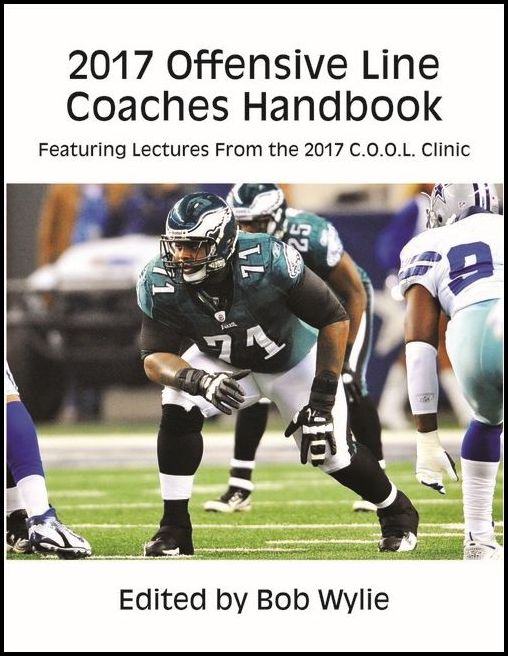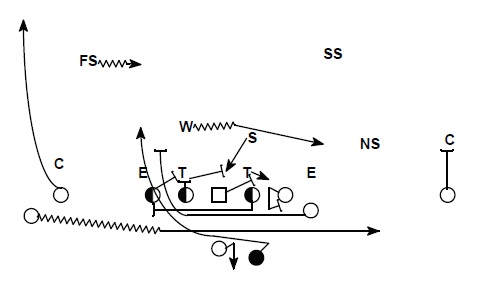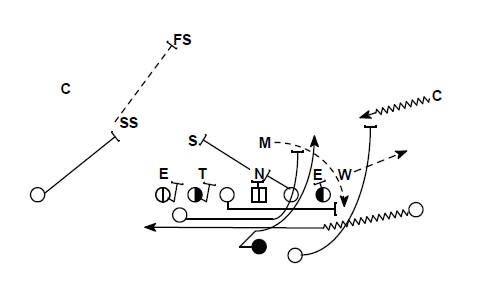The Three Blocking Schemes Alabama Uses in Every Game
Posted by Mike Young on Jul 8th 2018
Alabama's offense relies on a lot of motion. In fact, according to offensive line coach Brent Key, the Tide used some kind of jet sweep motion on about 30% of their plays during the 2016 season.
The problem with using so much motion is that you're not always sure how the defense will react to it. If you start moving people around, then the defense will usually start moving people around, and it can make it difficult for your offensive line to figure out where they're supposed to go.
That's why the Crimson Tide offense has these three calls for the offensive line we're gonna be talking about today. Instead of making the guys up front guess where they're supposed to go, Alabama's coaching staff uses game planning and three simple blocking scheme adjustments that simplifies everything and makes the offensive line's assignments crystal clear.
Thanks to the 2017 Offensive Line Coaches Handbook, you can read all about the way some of the best offensive lines in the country teach, install, and adjust what they do. The following quotes in this article are taken directly from this book. Get your copy now!

1. "Lock It"
The first call is the "lock it" call, which means the play will be using true man blocking. If you've got the Mike pre-snap, you've got him all the way.
Coach Key explains:
"We have three ways in which we block it. If we "lock it", Mike's the Mike and the Will's the Will, and we're blocking those guys. I don't care who else is coming, what type of motion, how they're moving. These guys are coming off on their double-teams, they're trying to get movement on the down guys, and wherever those backers end up, we own them.
"All double-teams and combos go to the original declaration. Then, any extra defenders off the edge are either going to be handled by the quarterback or the running back, because, as a rule, the receivers aren't able to block, since they are going in jet motion. You might be running to a nub side."

Simple, right? It's easy for the guys up front to understand and there's not a lot of thinking involved. Just find your guy and go get him.
Unfortunately, that doesn't always work.
2. "Push It"
What if you're playing against a team that likes to bring a lot of pressure, and you're afraid you won't have enough blockers to handle everything?
You can either abandon your plan and allow the defense to force you into something you don't want to do, or you can make an adjustment and find a way to stick with your base offense.
Coach Key explains the process of using a "push" call, sometimes called a "plus one" mentality:
"In this instance, all of the doubles and the combos move over a man. If we're running an inside zone, that doesn't mean we're going and running flat and going out to the guy. We're still staying heavy on those doubles, trying to get vertical movement at the line of scrimmage. We know that the double-team will be working to an extra guy.
"Who's responsible for that? The center and/or the tackle, at that point, becomes responsible for knowing if that guy is coming off the edge, or if the extra guy is fitting in the box. Then, the tackle will be able to make our R/L call to push it over one, or the center can, if he sees a guy coming down in the box."
The "push it" call is for the linemen, but sometimes Alabama can get creative and add an extra blocker to the mix to keep their counter play a threat.
In the diagram below, Coach Key breaks down on of the Tide's quarterback counter plays from an "over" or "unbalanced" set:

"In this instance, we’re running the play from an unbalanced set, with the X receiver coming in motion. By game planning and looking at this, we know that there might be an extra guy down here to the playside of the gap scheme. By watching film, we know the corner was going to hang back. As a result, we load the running back on him to create the extra hat for the quarterback to run.
"For the linemen, all of the rules stay the same. We like the counter play and gap scheme a lot better, when we know where those backers are going to be and that the defense is not going to bring a corner back into the box. You’ll see that when we get to some of the zone schemes in a minute, that’s when that stuff really starts changing, with the track blocking."
3. "Track Blocking"
The last adjustment Alabama's offense brings into every game is, you guessed it, zone blocking, or what they call "track blocking".
The linemen stay on a pre-determined "track" and don't chase defenders either direction.
Coach Key explains more:
"To me, track blocking sounds easy. Out of the three ways, however, I've had the most issues with it. The linemen start looking. They start trying to find out what the guy's going to do. Is he going to come back? Are they going to have two guys in a gap?What are they going to do? At that point, they start playing a little slower. As such, they don't always trust what you tell them.
"Most of my guys, when I'm talking about the IDs in these plays, want to know who they're going to block. They don't like to hear me say, 'We're going to track block this and whoever comes and shows.' They want to know who they're go to go block. Then, they can really get their hand in the dirt, come off the ball and really get movement on those down guys."
Coach Key goes into more detail about the specific uses of "track blocking" later on in the chapter:

"We have the jet motion coming, and we’re running this from the pistol. For the linemen, it’s no different than running it from under center. We’re running this out of an unbalanced formation, X off the ball, coming across—same thing that Coach Drevno was just talking about with the sweep to the field. Because of what we saw on film, we knew the corner was going to run and that the box would stay the same. As a result, going into the game, we knew that the corner would chase the motion. As such, we were going to lock this, until they made us change it. We carry all three of those into the game, whether we’re locking it, we’re tracking it or we have to plus it."
To learn even more about the ins and outs of Alabama's running game, get your copy of the 2017 Offensive Line Coaches Handbook: Featuring Lectures From the 2017 C.O.O.L. Clinic.
